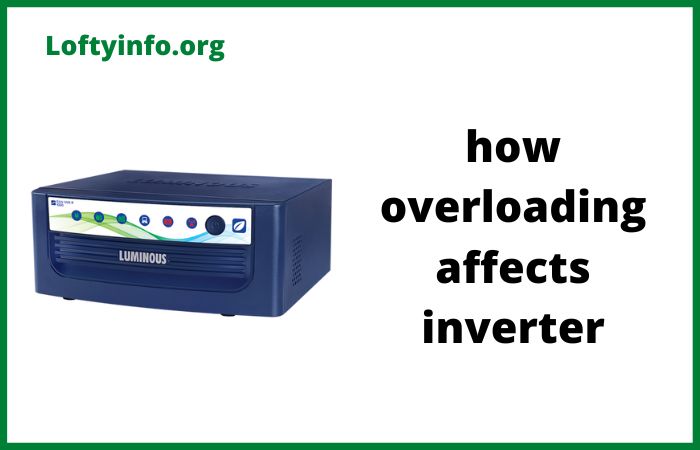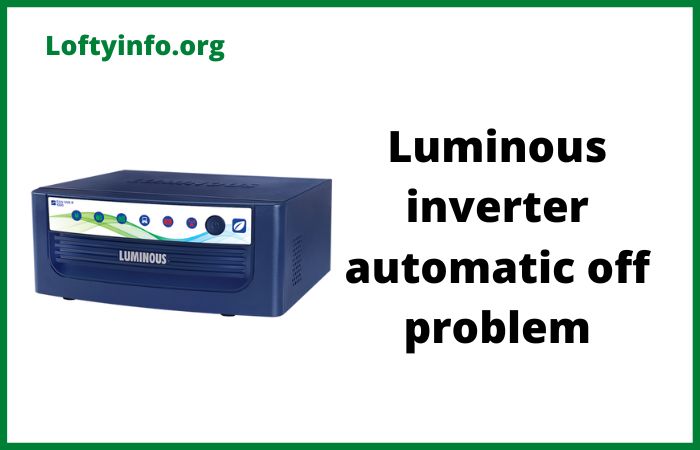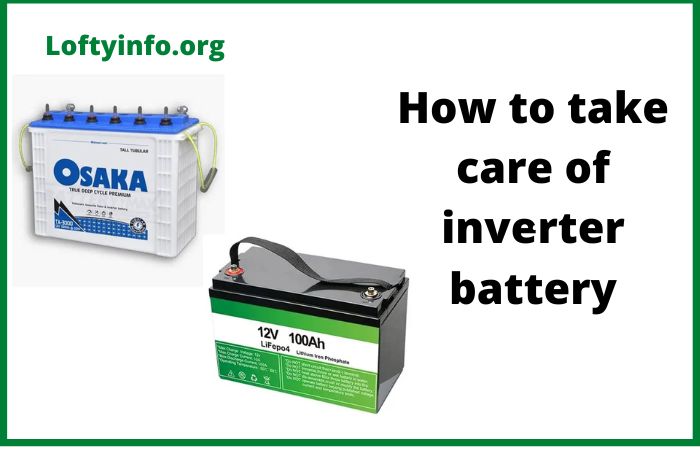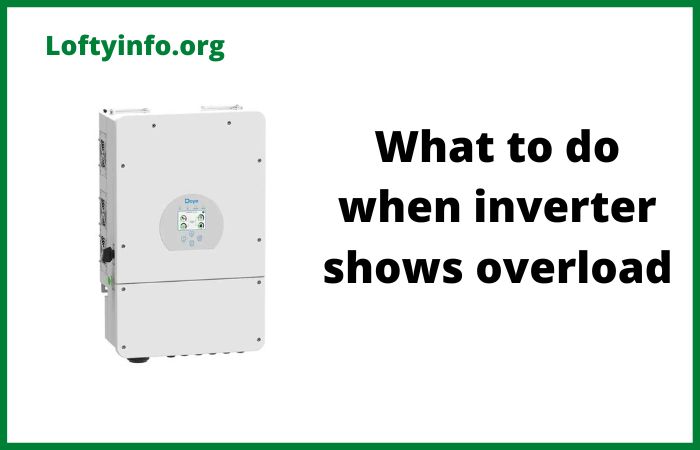How Inverter Overload Affects Performance
Inverters have become essential devices in modern homes and businesses as they convert direct current from batteries or solar panels into usable alternating current for everyday appliances.
Understanding inverter overload is crucial for anyone relying on backup power systems or off-grid electrical setups.
An overload condition occurs when the total power demand from connected appliances exceeds the inverter’s rated capacity causing potential damage to the unit and disruption to your power supply.
This comprehensive guide explores the nature of inverter overload and its significant impacts on system performance and longevity.
How Inverter Overload Affects Performance
1) Understanding Inverter Capacity and Load Limits
Every inverter is designed with a specific power rating measured in watts or kilowatts that represents the maximum continuous load it can safely handle.
This rating appears on the inverter’s nameplate and user manual as the continuous power output.
Most quality inverters also feature a surge power rating that allows brief power spikes typically lasting a few seconds to accommodate the startup requirements of motors and compressors.
An overload situation develops when you connect devices that collectively draw more power than the inverter’s continuous rating.
The relationship between inverter capacity and connected load determines system stability.
A 1000-watt inverter can theoretically power devices totaling 1000 watts simultaneously but running at full capacity continuously generates excessive heat and stresses internal components.
Manufacturers recommend operating inverters at 80 percent of their rated capacity for optimal performance and longevity.
Exceeding the rated capacity triggers protective mechanisms built into the inverter including automatic shutdown alarms and in some cases component failure if protection systems malfunction.
Understanding power consumption of your appliances helps prevent overload conditions. Resistive loads like incandescent lights and heating elements draw consistent power that matches their rated wattage.
Inductive loads including refrigerators air conditioners and power tools require significantly more power during startup than during normal operation.
A refrigerator rated at 150 watts running load might demand 600-800 watts for 2-3 seconds when the compressor starts.
Calculating total connected load must account for both running watts and starting watts of all devices that might operate simultaneously.
Modern inverters incorporate sophisticated monitoring systems that track real-time power consumption and alert users when loads approach maximum capacity.
Digital displays show current wattage draw allowing you to see exactly how much power your connected devices consume.
Smart inverters with mobile app connectivity send notifications when power usage reaches concerning levels.
These features help users manage their electrical consumption and prevent accidental overload situations that could damage equipment or interrupt critical power supply.
2) Immediate Effects on Inverter Performance During Overload
When an inverter experiences overload the immediate performance impacts are dramatic and often dangerous to both the inverter and connected equipment.
The most noticeable effect is the rapid temperature increase inside the inverter housing as the power electronics work beyond their thermal design limits.
Transistors capacitors and transformers generate heat proportional to the current flowing through them and excessive current from overload conditions produces dangerous temperature levels.
Most inverters have thermal sensors that detect overheating and initiate protective shutdown before components reach failure temperatures.
Output voltage instability represents another critical performance degradation during overload. Inverters maintain a steady 120 volts or 230 volts depending on your region through precise control circuitry.
Excessive load causes the output voltage to sag or drop below acceptable levels as the inverter struggles to maintain regulation.
Sensitive electronic devices like computers medical equipment and modern appliances with microprocessors malfunction or sustain damage when supplied with voltage outside their tolerance range.
Voltage sags below 10 percent of nominal can cause equipment to reset unexpectedly or fail to operate correctly.
The inverter’s output frequency which should remain stable at 50 Hz or 60 Hz can also fluctuate during overload conditions.
Frequency variations affect motor speeds causing fans and compressors to run irregularly. Clocks and timing circuits in various appliances lose accuracy when frequency deviates from standard.
Severe frequency instability causes humming noises from transformers and motors and accelerates wear on mechanical components designed for constant speed operation.
Harmonic distortion increases significantly when inverters operate in overload conditions. Pure sine wave inverters are designed to produce clean AC power with minimal harmonic content matching utility grid quality.
Pushing the inverter beyond its capacity introduces distortions in the waveform shape creating harmonics that interfere with sensitive equipment.
Audio systems produce buzzing sounds when powered by distorted waveforms. Variable speed drives and modern electronics with power factor correction circuits malfunction when fed harmonic-rich power.
The total harmonic distortion percentage rises dramatically as load increases beyond rated capacity compromising the quality advantage of premium inverters.
3) Long-term Degradation and Component Damage
Repeated overload events even if brief cause cumulative damage to inverter components that significantly reduces the unit’s operational lifespan.
Power transistors and MOSFETs that switch the DC input to create AC output endure enormous stress during overload.
These semiconductor devices have maximum current ratings that when exceeded accelerate junction degradation through thermal cycling and localized heating.
Each overload episode causes microscopic damage to the semiconductor crystal structure eventually leading to catastrophic failure where the transistor fails short or open circuit.
Capacitors throughout the inverter circuit suffer accelerated aging from overload conditions. Electrolytic capacitors in the DC input filtering and AC output smoothing stages operate with voltage and ripple current ratings.
Excessive current flow during overload increases the internal heating of capacitors causing the electrolyte to evaporate faster than normal.
As capacitors lose electrolyte their capacitance decreases and equivalent series resistance increases leading to reduced filtering effectiveness and eventual failure.
Output capacitor failure results in increased voltage ripple that damages connected equipment and reduces inverter efficiency.
Transformers and inductors used in many inverter designs experience insulation breakdown from repeated thermal stress during overload events.
The wire windings in these magnetic components are coated with thin insulation layers rated for specific temperature maximums.
Exceeding these temperatures causes the insulation to become brittle and crack creating potential short circuits between winding turns.
Transformer failures typically manifest as buzzing sounds reduced output voltage and eventually complete shutdown due to internal shorts.
The cooling system components including fans heat sinks and thermal interface materials degrade faster when the inverter regularly operates in overload.
Cooling fans designed for normal operating temperatures must run continuously at maximum speed during overload causing bearing wear and motor fatigue.
Heat sinks cannot dissipate the excess thermal energy effectively leading to higher component temperatures despite maximum cooling effort.
Thermal paste between power semiconductors and heat sinks dries out and cracks more quickly under extreme temperature cycling reducing its effectiveness and creating localized hot spots.
4) Impact on Connected Appliances and Equipment
Inverter overload conditions create hostile electrical environments that threaten the safety and functionality of connected appliances.
Voltage sags during overload cause lights to dim noticeably and motors to slow down or stall completely.
Refrigerators and air conditioners may fail to start because their compressor motors cannot generate sufficient torque at reduced voltage.
Electronic equipment with switching power supplies often includes undervoltage protection that shuts down the device when input voltage drops too low preventing operation even though the inverter is still running.
Microprocessor-based appliances and computers are particularly vulnerable to the unstable power conditions created by inverter overload.
These devices require clean stable power within tight voltage tolerances to operate reliably. Voltage fluctuations cause data corruption in computer memory and storage systems potentially resulting in lost work or damaged files.
Control boards in modern appliances including washing machines dryers and dishwashers contain sensitive electronics that reset or malfunction when power quality degrades.
Repeated exposure to poor power quality shortens the lifespan of these expensive control modules.
Motor-driven appliances suffer mechanical damage when operated during inverter overload conditions.
Electric motors are designed to run at specific voltage and frequency combinations that produce optimal torque and speed.
Reduced voltage forces motors to draw increased current to maintain the same power output causing excessive heating in motor windings.
This thermal stress deteriorates winding insulation and increases the risk of motor burnout.
Pumps fans and compressors experience premature bearing failure when operating at incorrect speeds due to voltage or frequency variations.
The power factor of connected loads deteriorates during inverter overload affecting overall system efficiency.
Many modern appliances use capacitors to correct their power factor and minimize reactive power consumption.
These power factor correction circuits operate based on expected voltage and frequency characteristics.
When the inverter provides distorted voltage or unstable frequency the correction circuits may amplify problems rather than solve them.
Poor power factor increases the current draw from the inverter for the same real power output exacerbating the overload condition and creating a negative feedback loop.
5) Battery Bank Stress and Reduced Backup Time
Inverter overload directly impacts the battery bank that supplies DC power causing accelerated degradation and dramatically shortened backup runtime.
When an inverter draws excessive current to attempt meeting an overload demand the battery bank must supply proportionally higher DC current.
Batteries have maximum discharge rate specifications expressed as C-rates that define safe current limits.
Exceeding these rates causes rapid voltage drop internal heating and permanent capacity loss in the battery cells.
Lead-acid batteries commonly used in inverter systems suffer severe damage from high discharge rates associated with overload conditions.
The chemical reactions inside lead-acid cells generate heat and when current draw exceeds design limits this heat production accelerates.
Excessive temperature causes active material in the battery plates to shed reducing the available surface area for future reactions.
Repeated high-rate discharge cycles cause sulfation where lead sulfate crystals grow large and hard becoming difficult to convert back during charging.
This permanent sulfation reduces battery capacity and increases internal resistance creating a downward spiral in system performance.
Lithium-ion battery banks while more tolerant of high discharge rates than lead-acid still experience stress during inverter overload.
The battery management system in lithium systems monitors cell voltages and temperatures shutting down output if dangerous conditions develop.
During overload the battery protection may trigger before the inverter protection cutting power unexpectedly and potentially causing data loss or equipment damage.
Frequent protection events due to overload shorten lithium battery lifespan by increasing the cycle count and causing imbalanced cell discharge.
The backup runtime calculation becomes meaningless during overload conditions as the increased current draw depletes batteries much faster than rated capacity would suggest.
A battery bank rated for 5 hours of backup at normal load might provide only 1-2 hours when the inverter operates in overload.
The Peukert effect in lead-acid batteries causes available capacity to decrease non-linearly as discharge current increases.
A battery rated for 100 amp-hours at a 20-hour discharge rate might deliver only 70 amp-hours when discharged at a 1-hour rate.
Users expecting extended backup time during power outages find their systems depleted quickly if loads exceed inverter ratings placing additional stress on the entire power system.
How to properly charge an inverter battery at home
What to do when Inverter shows low battery too quickly explained






